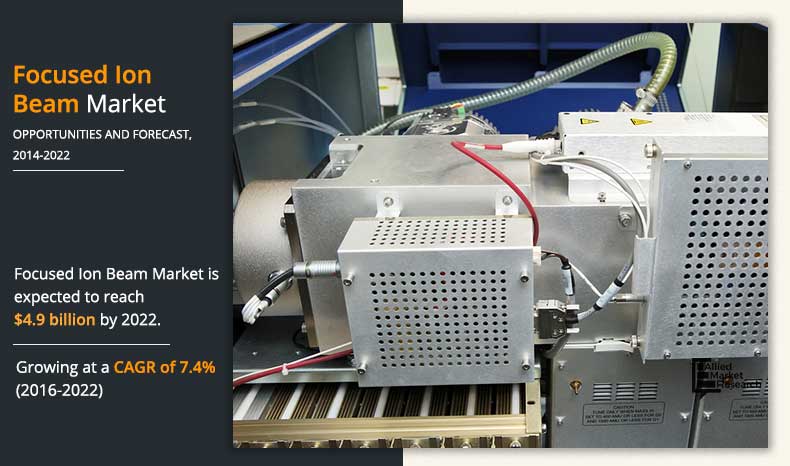Focused Ion Beam Market Outlook - 2022
The global focused ion beam (FIB) market is projected to reach $4.9 billion by 2022, registering a CAGR of 7.4% from 2016 to 2022. Focused ion beamis a high-energy ion beam produced by FIB-enabled equipment. This equipment is majorly used in semiconductor industry and in 3D imaging techniques. Increased R&D investment for materials science and bio materials is a major factor that boosts the growth of the market. Increase in demand for FIB-based failure analysis equipment in electronics industry and circuit editing application using FIB are other major factors that propel the focused ion beam market growth.
Key players have introduced technologically upgraded FIB equipment such as multibeam FIB system. However, high cost of theseequipment is a major restrain of focused ion beam market. Development of new ion sources such as helium, lithium, and others provides growth opportunities for the market. Despite high success of FIB micro equipment, development of nano-FIB equipment is anticipated to be the major attraction in the year to come.
The focused ion beam market is segmented on the basis of ion source, application and geography. Based on ion source, the market is segmented into iridium, gold, gallium, and others. By application, the market is categorized into failure analysis, material science, nanofabrication, device modification, circuit edit, and others. Geographically, the market is analyzed across North America (U.S., Canada, and Mexico), Europe (UK, France, Germany, Russia, Spain, and rest of Europe), Asia-Pacific (India, China, Japan, Australia, and rest of Asia-Pacific), and LAMEA (Latin America, Middle East, and Africa).
The key players profiled in the focused ion beam market report include Hitachi High-Technologies Corporation, Evans Analytical Group, Fibics Incorporated, FEI, Carl Zeiss AG, ZEROK Nanotech, Thermo Fisher Scientific Inc., NanoLab, Tescan, and Waters. These key players have adopted various strategies such as product portfolio expansion, mergers & acquisitions, agreements, geographical expansion, and collaborations to increase their market penetration and strengthen their position in the industry.
Key Benefits for Stakeholders:
- Comprehensive analysis of the current trends and future estimations in the global focused ion beam market is provided.
- The report offers a competitive scenario of the focused ion beam market with growth trends, structure, drivers, scope, opportunities, and challenges.
- It includes a detailed analysis of the key segments to provide insights on market dynamics.
- Porters Five Forces analysis highlights the potential of buyers and suppliers as well as the competitive structure of the focused ion beam market to devise effective growth strategies and facilitate better decision-making.
Focused Ion Beam Market Report Highlights
| Aspects | Details |
| By Ion Source |
|
| By Application |
|
| By Geography |
|
| Key Market Players | Tescan, Hitachi High-Technologies Corporation, ZEROK Nanotech, Carl Zeiss AG, Waters, FEI, Evans Analytical Group, Fibics Incorporated, NanoLab |
Analyst Review
The global focused ion beam market has a lucrative scope of growth during the forecast period. In 2015, North America generated the maximum revenue, followed by Asia-Pacific. Electronics and semiconductor industries are on rise in the Asia-Pacific region. Moreover, investment in R&D in these industries has increased substantially worldwide. Although high cost of FIB equipment is major challenge, innovation of cost-effective FIB equipment presents major opportunity for market growth. The FIB market is segmented based on ion source (gallium, gold, and iridium) and application (failure analysis, circuit edit, device modification, and material science). Failure analysis and circuit editing hold major market share of the global FIB market.
Increased R&D of new ion sources, such as lithium, companies try to develop advanced and cost-effective technologies. Since the market is niche, multiple prominent players to gain their foothold in the market. High investment expenditure in R&D has resulted in increased cost of FIB equipment. Since the industry demands continuous innovation, high cost of the FIB is expected to restrain the market growth. However, with the entrance of new players and tough competition between the well-established companies, the prices are expected to drop.
Loading Table Of Content...




